Best speaker cables 2025: our editors' choice for every budget
Don't fall at the final hurdle of system building
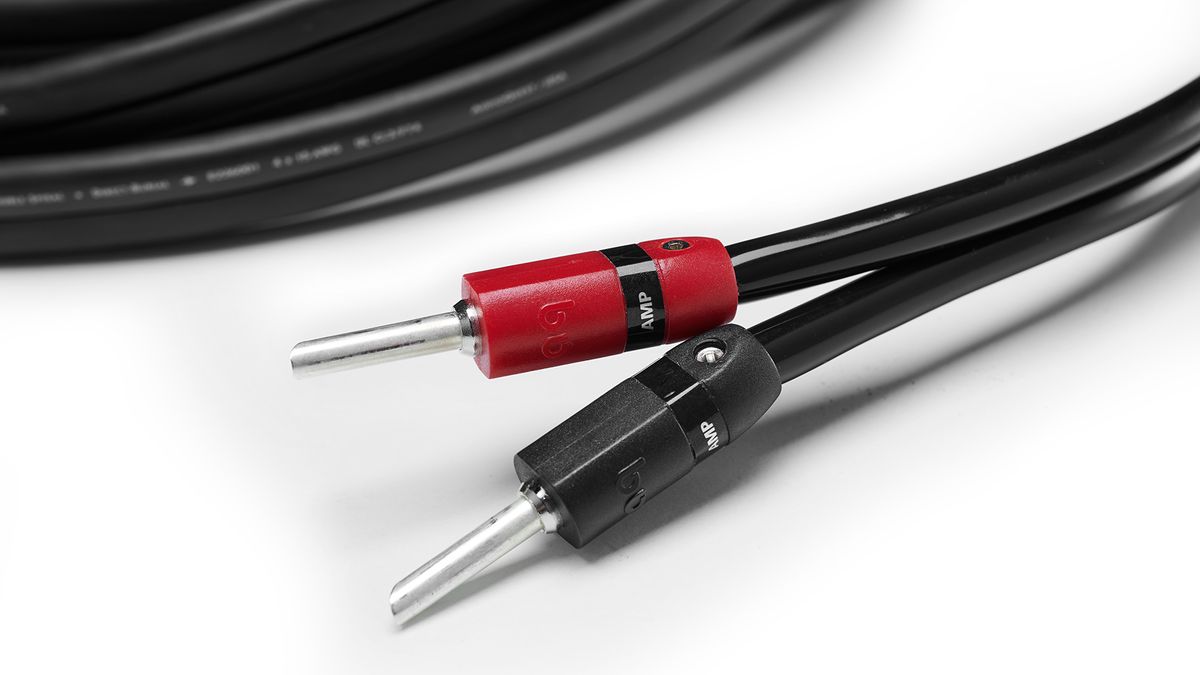
You don't have to completely overhaul your system if you want a sonic upgrade; sometimes the simplest way to give you system a refresh is by updating the cables.
Whatever your opinion on the sensitive matter that is cables, it is undeniable that they make a difference. As passive components that carry sound between system components, speaker cables can't make your system sound better than it actually is; but the best ones are those that degrade the audio signal the least and ensure that every last drop of performance makes its way from your amplifier to your speakers.
Sub-par cables are often a limiting factor within a hi-fi system and can even make it sound worse than it really is, which is why we always recommend investing in the best cabling within your budget when buying or upgrading a system. Dedicating 10 per cent of your total system cost to speaker cables (and the interconnect audio cables between your electronics) is a good place to start.
So without further ado, here are the best speaker cables that our expert in-house reviews team has tested inside our state-of-the-art facilities, starting with the current What Hi-Fi? Award winner...
The quick list
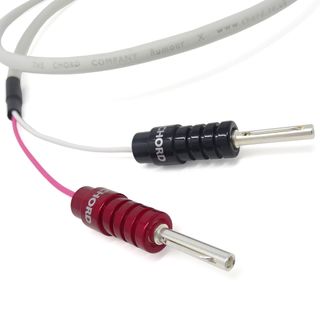
Chord's Rumour cable has been our go-to recommendation for years, and improved metallurgy for the latest 'X' version doesn't change that.
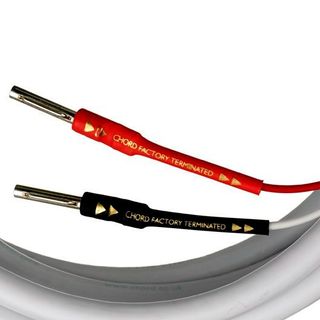
Looking for a solid starter cable for your modest hi-fi system? Chord Company's cheap C-Screen makes a whole lot of sense.

The extra transparency of the excellent Rocket 11 speaker cable makes it well worth that extra investment.
Load the next product ↓
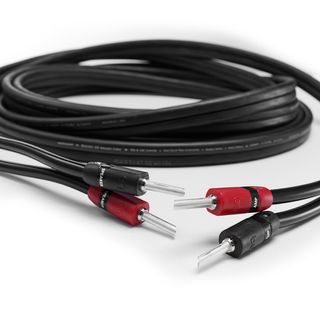
A level-up, well-balanced cable that should work well in a wide range of systems.

I am What Hi-Fi?'s managing editor and have been reviewing and writing about hi-fi for over a decade, years of which I spent in our state-of-the-art testing facilities on a daily basis, going hands (and ears) on with every bit of kit that passed through its doors – including speaker cables. They may not be sexy, or the first thing you think about when system building, but overlook their importance to whole-system performance at your peril. Ideally, you should spend roughly 10 per cent of your system cost on cabling (speaker cables and interconnects), so if one of our tried-and-tested picks below aligns with your budget, know that it is a well-built cable that won't hinder your electronics' talents. Still, before buying, read our review to ensure its character will be compatible with your hardware.
Best speaker cable overall
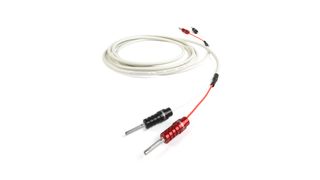
Specifications
Reasons to buy
Reasons to avoid
The original Rumour was introduced way back in 1996 and at the time was only Chord’s second attempt at a speaker cable. This audiophile speaker cable has seen various iterations since then, with the previous five-star RumourX (2018) now superseded by the latest RumourX (2022) model.
It's incremental changes throughout, but all of these add up to a fine performance upgrade at this price.
Chord’s development work with high-end ranges such as ChordMusic and Sarum T showed significant improvements could be made to the Teflon dielectric material used. While the subsequent high-end solution of Taylon proved too expensive to use in products such as the RumourX, a more reasonably priced alternative XLPE (Cross-linked Polyethylene) was found instead in the 2018 model. Chord has introduced a new multi-metal alloy for the pug plating in the 2022 model (changed from the previous silver), which supposedly tarnishes less over time and offers better connection quality.
With the Chord cable plumbed-in, our reference hi-fi system delivers a crisp, clean and dynamic presentation, just as before. Our reviews team compare it to next to a sample of the previous-generation Rumour and found that the basic character of the cable hasn’t changed: "This is still a detailed and dynamically expressive performer that’s unusually surefooted when communicating rhythmic drive," our RumourX (2022) review reads.
But the bass performance is tauter, the top end is more refined and there's an ounce more subtlety. We’re impressed at the musically cohesive nature of the sound and the way our systems render subtle dynamic shifts with such finesse. It's not essential to upgrade if you already own the previous RumourX cables, but if they're looking a bit worn, this latest RocketX version will give your system a decent performance lift.
Read our full Chord Company RumourX (2022) review
Best budget speaker cable
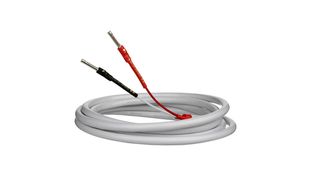
Specifications
Reasons to buy
Reasons to avoid
Monetary savings are not necessarily accompanied by a reduced level of technology or care on Chord Company’s part. The C-Screen's specifications are similar to speaker wires further up the British brand's hierarchy.
Beneath its white outer jacket, the C-Screen features what Chord Company describes as multi-stranded oxygen-free copper conductors, insulated with low-density polyethylene and arranged in a twisted-pair configuration to reduce interference. The white outer covers a PVC casing designed to reduce mechanical noise and space the conductors correctly.
So what is all of that in today’s money? Essentially it translates to recognisable Chord Company performance, favouring your system's cohesion and musical performance over outright analysis. "Tracks... characterised by its drive are held together as if with superglue, but without ever sounding mechanical," notes our C-Screen review. Our in-house reviews team tested it within our top-level reference system and a more financially appropriate one, and with each the Chord impressed.
What it does well, it does better than anything else we’ve heard at this price, though if your system sounds warm enough already, you may prefer a cable that won’t significantly add to that. An alternative cable that prioritises space and detail is the QED XT25.
Read our full Chord Company C-Screen review
Best mid-price speaker cable
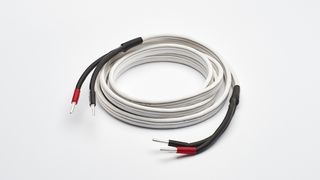
Specifications
Reasons to buy
Reasons to avoid
AudioQuest’s Rocket 11 – at the budget end of its Rocket range – could just be the hi-fi speaker cable to give your system a new lease of life. We love it so much it's been a What Hi-Fi? Award winner several years running now, having batted off new competition to keep its crown for many moons.
AudioQuest has taken a lot of care with the configuration and quality of the conductors used inside the Rocket 11. It uses semi-solid true-concentric conductors and long-grain copper – all to improve performance and reduce any interference that might degrade the sound.
There’s a perceptible improvement in the way systems perform when the Rocket 11 is plugged in, compared with rival speaker cables. Music sounds crisp and clean, with a punchy sense of dynamism that's a joy to listen to.
The similarly priced QED Reference XT40i lets through more detail and therefore could be the preferred choice for anyone whose hi-fi is built upon clarity and analysis, but we find the Rocket 11 offers more of a musical whole, which is a lot to do with dynamic expression and organisation, and that does it for us more so than the extra information. As our Rocket 11 review concludes, "the best thing this AudioQuest cable does is get out of the way and simply let you enjoy the music".
Read our full AudioQuest Rocket 11 review
Best premium speaker cable
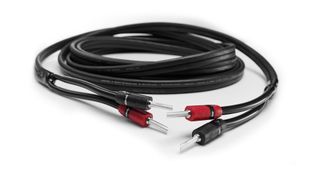
Specifications
Reasons to buy
Reasons to avoid
The Rocket 22 continues the fine work of its multi-Award-winning sibling, the Rocket 11, and, in a suitably talented set-up, the difference in price between the two can be justified by the improvement in scale, detail and authority.
The design of this audiophile speaker cable mirrors that of the cheaper model but uses higher quality copper conductors with a polished outer surface that’s claimed to give a ‘sweeter’ high-frequency performance. The conductors use strands arranged in concentric layers, where each layer spirals in the opposite direction to the one below it.
The cable also uses AudioQuest’s Noise Dissipation System, which is essentially specially designed layers of shielding that reduce the impact of RF (Radio Frequency) interference and EMI (Electromagnetic Interference).
In both the reference-level and more modest systems we plumb the Rocket 22 into during testing, we enjoy a spacious and refined presentation – "one that sounds noticeably larger scale than when we substitute talented cheaper alternatives such as the Chord Company RumourX [above]," reads our Rocket 22 review.
It carries an impressive amount of fine detail, arranging it in a stable and cohesive manner and presenting it even-handedly without emphasis, and despite its civilised nature there’s still enough in the way of dynamic punch and rhythmic drive to allow a track's sheer energy and attack to shine through.
All of this makes for an easy-going balance that makes the Rocket 22 suitable for a wide range of systems.
Read our full AudioQuest Rocket 22 review
Also consider
- QED Golden Anniversary XT: Pricier but delivering more outright clarity and detail precision than the Chord Company RumourX. The Chord replies with greater rhythmic drive and dynamic expression, but the choice between the two comes down to whether you place resolution, tonal neutrality and openness above the more visceral aspects of music replay.
How to choose the right speaker cables
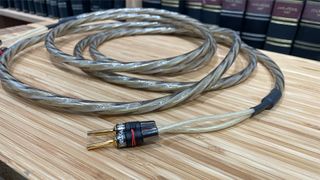
If you're embarking on getting new speaker cables for your system, a starting point could be to get in touch with the manufacturer of your stereo speakers and ask if they recommend a particular brand or model of cable. After all, engineers will have spent hours experimenting during the development process and you might be given a valuable nugget of information that might make your job of finding something suitable more simple.
You could also speak to your dealer to see if they've tried different speaker cables during demos and have found any that work particularly well with your pair of speakers. First-hand advice is always valuable. Alternatively, our list above offers a trio of the best cables we have found to work well in several varied systems.
Do remember to budget for the lengths of speaker wire that you need (and the number of speakers you're wiring up if it's a surround system) and bear in mind that the cable prices we quote in our reviews and buying guides usually don't include the banana plugs that you'll see in the pictures – you can specify lengths and termination during the buying process.
Banana plugs make connecting, unplugging and reconnecting easier, but they don't make the sound any better. In fact, many people believe a bare wire connection to be sonically superior. You might also want to consider bi-wiring if your speakers are compatible (i.e. they have four speaker terminals as opposed to just two).
Otherwise, when it comes to picking the right speaker cables, a lot of your decision-making will revolve around price and your specific hi-fi system. As a general rule of thumb, we'd recommend setting aside 10 to 15 per cent of the total cost of your system for all cables. In the case of a hi-fi set-up, you'll be looking at analogue interconnects, speaker cables and, potentially, a digital optical or coaxial cable depending on the sources you're using. So you'll want to dedicate a share of this to a pair of suitable speaker cables.
If you currently own an excellent entry-level set-up, you may not feel the need to spend big on cables, and that's totally fine. However, you might find that trying a new set of cables is an easy and effective way to upgrade your system's sound without spending big bucks. As you can see from our list above, there are some brilliant affordable options available.
How we test speaker cables
What Hi-Fi? has been reviewing speaker cables for almost 50 years, and today our reviews remain as independent, honest and trusted as ever across print and online.
The current What Hi-Fi? team, which has more than 150 years of collective experience in reviewing, testing and writing about consumer electronics, has access to purpose-built, acoustically treated testing facilities in London and Reading. Indeed, all of our testing is done in-house, giving us complete control over the reviewing process and ensuring we are consistent across all product reviews.
It also allows us to keep stock of a wide variety of kit – mostly benchmark class leaders and five-star products – so that we can compare new products against the ones we know and love. Comparisons are bread-and-butter to our reviewing process and ensure we have the widest contextual knowledge of every corner of a market. This is particularly helpful for speaker cable reviews as it allows us to plumb the wires into numerous systems of varying price and tonal character, ensuring we can offer advice on which sonic flavour of systems they would best suit. Testing them within our reference system can really reveal what the speaker cable is doing (or not doing), while plugging them into a more price-compatible setup is also vital to gauge their 'real-world' effect.
Whether tested individually or collectively during our What Hi-Fi? Awards judging process, all speaker cables are listened to by multiple members of the What Hi-Fi? reviewing team at one time. The final review verdict is agreed upon by the team as a whole rather than a single reviewer, to help ensure consistency and avoid individual subjectivity and biases. Manufacturers, PRs and commercial teams have zero impact on them – which is why our reviews are trusted by readers, retailers and manufacturers alike.
From our reviews, we hand-pick only the best speaker cable at each price to feature in this Best Buy guide. That's why if you take the plunge and buy one of the products recommended here, you can rest assured you're getting a What Hi-Fi?-approved product.
You can read more about how we test and review products on What Hi-Fi? here.
Speaker cable FAQs
How do you connect speaker cables?
A speaker cable has one positive (red) and one negative (black) strand, so you should connect them to the corresponding colour sockets on your amplifier and speaker. Red goes into red, for example. (If your cable doesn't have a coloured sleeve, gold is usually the positive one. Or look for any printed + or – symbols.) Make sure you're connecting your amp's left channel to your left-channel speaker, too.
Some cables have wording or arrows on their insulation sleeves denoting the ideal directional flow and which end should go in which component.
Cable wires come bare and can be simply stripped (exposed) at the end, twisted and inserted into a component's binding post. But we'd recommend you opt for banana plug termination at the point of purchase for a more stable connection and easier unplugging.
Bi-wire or single wire?
If your speakers and amplifier accommodate bi-wiring, they will have four instead of two terminals for you to connect your speaker cables. Unlike single wiring, where all frequencies are propelled toward your speakers together, bi-wiring allows your amp to drive upper- and middle/low-frequency signals separately, with the aim of a purer sound with superior precision. If you can and want to bi-wire, you'll want speaker cables terminated as such – and they are pricier, or you can connect using a single wire to each speaker.
Note that if you want to single-wire your bi-wirable speakers, you'll need to attach the supplied connectors/links so that the audio signal reaches each driver.
Can speaker cables be different lengths?
Yes. Retailers allow you to specify what lengths you need to the metre or, less commonly, half-metre, with quoted prices typically by metre. Measure the distance between your amplifier (or other electronics) and speakers (ensuring your speakers are correctly positioned) so that the cables are just long enough to traipse along the floor.
You want to minimise speaker cables to reduce resistance (and cabling cost!), though both right and left cables should be the same length – even if one could be shorter – to ensure equal impedance.
Should I upgrade my speaker cable?
If it looks like the cables you are using are frayed, damaged or showing signs of physical wear – such as a break in the outer skin, wires poking out, contacts not being made resulting in the audio signal not coming through – then it is sensible to replace the cables for a fresh set. You don't have to spend hundreds on this either (unless you have a high-end system); a sturdy set will do.
We sometimes recommend upgrading your cables if you want to refresh your audio system but don't want to completely replace your kit. Equally, don't feel the need to replace cables unnecessarily if your existing cables are intact and of good quality, or if your new product purchase comes with cables included. If you do feel that the speaker cables are the weakest link in your system and need a better set, then our recommendations above are a good start.
You can read more tips on affordable ways to upgrade your system, as well as our tips on how to curb the need for upgrading and what to do instead if you are after a sonic refresh.
Recent updates
- February 2025: Checked all information is up to date.
- December 2024: No new entries this time, although we have tested a new set of Ecosse cables recently – but they don't make the cut here. We've also flagged our current 2024 What Hi-Fi? Award-winner in the speaker cables category.
- October 2024: Updated our buying advice and FAQs.
- April 2024: We added 'FAQ', 'Also Consider' and 'How we test' sections to offer you more buying advice and awareness of how What Hi-Fi? arrives at its verdicts.
- January 2024: We trimmed our list of the best speaker cables for more pointed recommendations at set price points.
MORE:
10 affordable ways to upgrade your hi-fi system right now
Our pick of the best audio cables you can buy
All of our test track playlists in one place: the ultimate music tracks to test your hi-fi system
Get the What Hi-Fi? Newsletter
The latest hi-fi, home cinema and tech news, reviews, buying advice and deals, direct to your inbox.
Becky is the managing editor of What Hi-Fi? and, since her recent move to Melbourne, also the editor of the brand's sister magazines Down Under – Australian Hi-Fi and Audio Esoterica. During her 11+ years in the hi-fi industry, she has reviewed all manner of audio gear, from budget amplifiers to high-end speakers, and particularly specialises in headphones and head-fi devices. In her spare time, Becky can often be found running, watching Liverpool FC and horror movies, and hunting for gluten-free cake.
- Kashfia KabirHi-Fi and Audio Editor
-
Mike Hunt Reply
Of course they can't. None of these cables work any better than a length of twin and earth cable you'd find in a skip. They might look nicer but they perform no better, and when you see that suppliers are offering a burn-in service, you just know that they're selling snake oil.abacus said:And you can provide independent verifiable proof of this?
Bill -
Mike Hunt Reply
It actually seems quite prevalent.Kurt Reply said:Oh a couple of know-nothing know-it-alls. What a rarity for a hi-fi forum. -
alantb Reply
Hi Billabacus said:And you can provide independent verifiable proof of this?
Bill
Having just spent a week reviewing three cables at home (Chord Epic X, Chord XL and Tellurium Q silver 2) I can say a firm 'yes'. There were substantial differences in the sound, and the enjoyment of the music they offered. I even involved two intelligent sceptics - my wife and an old friend; they were both surprised that they had a definite preference for one (luckily the same I liked!) and used words to describe their reasons that were similar to each other's and to mine.
Give it another go, maybe? -
Mike Hunt Reply
Utter nonsense! If someone could hear a difference then there was something drastically wrong with some of the cables. Send them back for a refund!alantb said:Hi Bill
Having just spent a week reviewing three cables at home (Chord Epic X, Chord XL and Tellurium Q silver 2) I can say a firm 'yes'. There were substantial differences in the sound, and the enjoyment of the music they offered. I even involved two intelligent sceptics - my wife and an old friend; they were both surprised that they had a definite preference for one (luckily the same I liked!) and used words to describe their reasons that were similar to each other's and to mine.
Give it another go, maybe?
Speaker cables sound different... LOL! -
alantb Reply
But the perceived differences were in the degree of rightness, not wrongness.Mike Hunt said:Utter nonsense! If someone could hear a difference then there was something drastically wrong with some of the cables. Send them back for a refund!
Speaker cables sound different... LOL! -
Ian Betts Replyalantb said:But the perceived differences were in the degree of rightness, not wrongness.
Mike Hunt..... If you say your name quickly enough, says it all really! 🤣🤣Mike Hunt said:Utter nonsense! If someone could hear a difference then there was something drastically wrong with some of the cables. Send them back for a refund!
Speaker cables sound different... LOL!
Perhaps you are confusing the conductance and resistance of an electrical cable when used for DC current or that of a 50Hz mains cable with the inductance and impedance of a cable when used to conduct an AC current with frequencies from 20Hz to 20kHz. The impedance of a cable can be quite different at different frequencies and this can clearly affect the voltage/current which arrives at the speaker terminals. It's not rocket science! -
Mike Hunt Reply
There are only one group of confused people here, and it's the audiophools.Ian Betts said:Mike Hunt..... If you say your name quickly enough, says it all really! 🤣🤣
Perhaps you are confusing the conductance and resistance of an electrical cable when used for DC current or that of a 50Hz mains cable with the inductance and impedance of a cable when used to conduct an AC current with frequencies from 20Hz to 20kHz. The impedance of a cable can be quite different at different frequencies and this can clearly affect the voltage/current which arrives at the speaker terminals. It's not rocket science!
I posted a reply earlier, with a link to all the information necessary to disprove this cable nonsense, but you either can't understand it or chose to ignore it, but if you do understand it, please feel free to offer a rebuttal, explaining why and where the information is incorrect.
https://books.google.ie/books?id=l1ul2d2jh0QC&pg=PA436&lpg=PA436&dq=RLC+lumped+element+analysis+cables&source=bl&ots=QsHFenkZKU&sig=ACfU3U39DF5U6iSvYtIhwqJrVA30IqLdmA&hl=en&sa=X&ved=2ahUKEwivlaW3hL7nAhWVVBUIHVswAMAQ6AEwFHoECA4QAQ#v=onepage&q=RLC%20lumped%20element%20analysis%20cables&f=false -
Ian Betts Reply
Hello Mike. I would be more than happy to read your supporting information but I cannot find the link in your previous post that you refer to. I see a link to a publication on Sound Engineering. Is that what you referred to? If not, could you be so kind as to repost your link?Mike Hunt said:There are only one group of confused people here, and it's the audiophools.
I posted a reply earlier, with a link to all the information necessary to disprove this cable nonsense, but you either can't understand it or chose to ignore it, but if you do understand it, please feel free to offer a rebuttal, explaining why and where the information is incorrect.
https://books.google.ie/books?id=l1ul2d2jh0QC&pg=PA436&lpg=PA436&dq=RLC+lumped+element+analysis+cables&source=bl&ots=QsHFenkZKU&sig=ACfU3U39DF5U6iSvYtIhwqJrVA30IqLdmA&hl=en&sa=X&ved=2ahUKEwivlaW3hL7nAhWVVBUIHVswAMAQ6AEwFHoECA4QAQ#v=onepage&q=RLC%20lumped%20element%20analysis%20cables&f=false
Thank you.